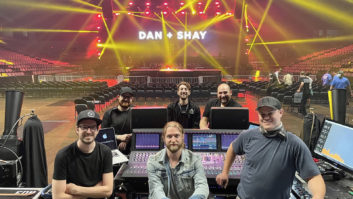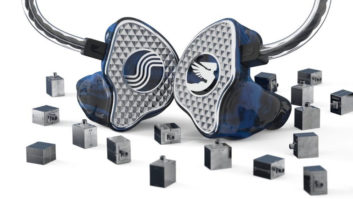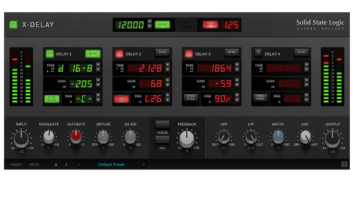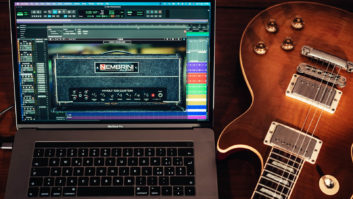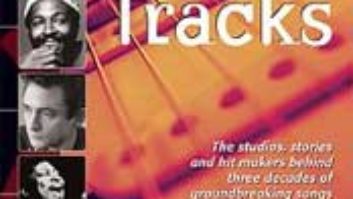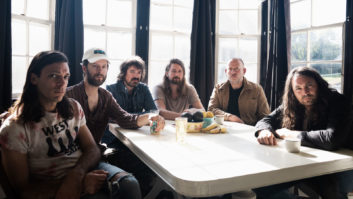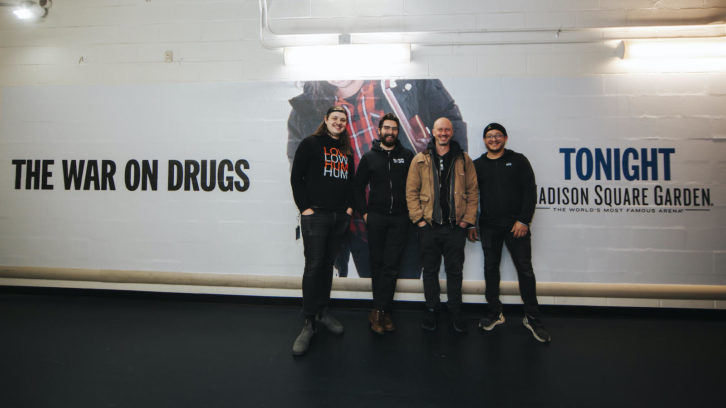
Playing New York’s Madison Square Garden for the first time is a landmark moment in any band’s career, and truthfully, the same goes for their production teams as well. For indie rockers The War On Drugs and their crew, that moment was set to finally happen January 29th, only a few weeks into the group’s tour behind 2021’s I Don’t Live Here Anymore album. Unfortunately, that date fell square in the middle of a massive three-day Nor’Easter—now officially known as the January 2022 North American Blizzard—which slammed the entire East Coast.
“There were many conversations while we were in Philly doing our show the night before,” recalled the band’s longtime monitor engineer, Laurence Eaves. “The general consensus was, if it’s safe, let’s go for it. The truck drivers and everyone were all in, so we showed up and it was Game On—a regular show day, but the first at MSG for the majority of us, so it was very exciting.”
Reaching that milestone was the latest success for a Grammy-winning band that’s released a string of critically acclaimed albums and toured behind them for more than a decade. The current year-long jaunt has Eaves and FOH engineer Bob Strakele, veterans of previous War On Drugs tours, returning to oversee monitor and control gear provided by Eighth Day Sound (Highland Heights, OH) with the help of A2, Ricardo Garcia. However, due to schedule conflicts, Strakele will soon be handing over the house desk to another engineer—Matthew Walsh, who previously was Eaves’ monitor tech on the band’s last tour in 2018.
With ‘I Don’t Live Here Anymore,’ The War on Drugs Find Beauty in the Journey
Strakele and Walsh both hail from Richmond, Virginia and already knew each other from the local scene, but while Strakele is usually on the road with acts like Slipknot, Avenged Sevenfold and Greta Van Fleet, the younger Walsh can often be found in Richmond, running his studio or doing post production audio. While he’s toured in various capacities, most recently as monitor engineer for singer/songwriter Julien Baker last fall, the jump to mixing house for an arena-filling band is substantial, so instead of Walsh getting thrown into the deep end, taking over at the end of Strakele’s stint, the tour is carrying two FOH engineers at the moment.
“On the technological side of things,” said Strakele, “Matthew’s an absolute whiz, but when you’re mixing a band with 110-plus inputs and seven people, a lot of what comes with the gig is learning their nuances and personalities as players, figuring out what they’re going to do at any certain moment—and that’s just something that comes with time. So every couple days, mostly when we do doubleheaders, he takes over the second show. We treat the day as if I’m not even there; he goes into the room, time-aligns the system, gets the console up, does line check, all that stuff—and so far, so good.”
The result is a unique collaboration between engineers that benefits everyone involved. “We’ve been working on separate show files,” Walsh explained, “but also discussing the overall aspects of the mix and what needs to get pushed. We’re able to address certain issues or discover, ‘Hey, this is really working well across both of our mixes,’ so we’re able to create an awesome show.”
Those mixes are being built on a Solid State Logic Live L550 console without the use of Scenes. “I only dive into that stuff if I feel like I don’t have enough fingers to get the job done,” laughed Strakele. “Anyway, the guys have such a freestyle way of performing that I don’t think it would work. It’s all hands on deck for the full concert, because you never know what’s gonna come at you.”
Well, most of the time, as Strakele’s tenure behind the desk has trained him to watch band leader Adam Granduciel to spot key moments before they happen. “We have a cool thing where after so many shows with him, he knows that if he makes a certain gesture or pick slide, I’m gonna effect it and treat it a certain way because I’m expecting it to come. We vibe off of each other that way. That being said, I’m not trying to make it bombastic the whole time; it’s a very dynamic band. When we do ‘Under the Pressure,’ that’s got quite a buildup and I’ll take it to 102 dB, but then the next song, we’re sitting under 90 and the crowd’s so quiet, you can hear a pin drop. I try to make the mix emotional; that’s my goal with these guys.”
That’s accomplished without third-party plug-ins, it turns out, with the engineers leaning on the desk’s stock effects, and a small outboard rack outfitted with a pair of Bricasti M7s, two Empirical Labs Distressors and an SSL Fusion analog master processor. “When we were prepping at the beginning of January, we noticed that everyone had a Fusion in their rack, so we decided to try it,” said Walsh. “There’s not a lot of other mastering and finishing devices that fit such a small footprint; the stereo width controls and drive controls are the two highlights for us.”
Over at stageside, Eaves also works on an SSL Live L550, making the most of recent update features like the onboard Blitzer compressor and Sourcerer primary source enhancer as he creates mixes that the band hears via JH Audio ear monitors. “We’re using some old JH13s that I still think sound absolutely fantastic,” said Eaves. “They have a very flat, neutral response, so I can craft whatever I want from them and give the musicians more of a live experience. I want the band to feel like they’re part of the best live record they’ve ever heard.”
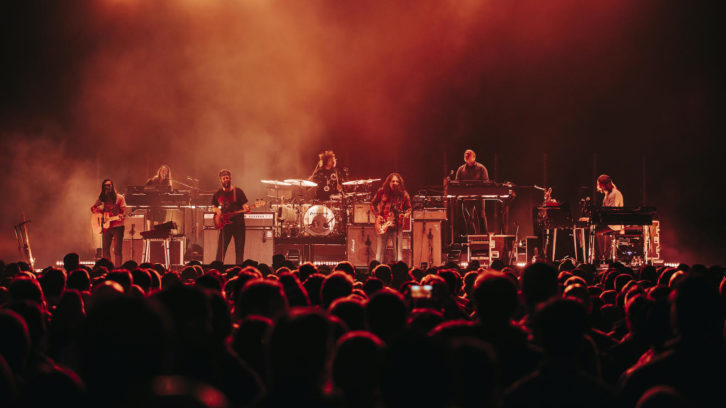
Helping make that happen is an 80-microphone arsenal—a mic locker more like a mic locker room. Drums are captured by a variety of mics, starting with an EV N/D868 as the outside kick microphone and a Beyer TG D71 used inside. Drummer Charlie Hall uses a single snare drum, and the top is double-miked with an sE Electronics V Beats, used to give weight to the snare sound, and a Josephson e22 condenser mic; more e22s can be found on the toms as well. Strakele has been using DPA 4099s for underheads on Slipknot, so those are now on Hall’s kit, along with a Beyer M 160 used as a central kit mic.
Beyer and sE mics appear again on the guitars, said Eaves: “sE kindly sent us some VR2s and I’m very impressed. I have four main channels for Adam—he’s running effectively two guitar amps with a Beyer M 201 and an sE VR2 on each. 201s give that brighter, more aggressive sound, while sEs have that smooth, thicker, ribbon sound, so as Adam’s messing with tones and progressing through the show, I can shape and push that into any direction I need to, blending between the four microphones.”
After years of always opting for a particular vocal mic, Granduciel’s voice is now nabbed by a DPA d:facto. “Eighth Day let us try one,” said Eaves, “and as soon as Adam sang a note into it, he said, ‘Okay, get a couple of these; we’re going to need them.’ It really does sound amazing; the rejection is incredible. My EQ with the DPA is almost flat, and it gives you a perfect picture of what Adam sounds like in front of that stage.”
A good-sounding rock show always sets the audience ablaze, but that January day at Madison Square Garden, it looked like there might not be much of a crowd to enjoy it. As snow piled up around the region, dumping nearly a foot on Manhattan and up to two feet in surrounding areas, most concerts around the city cancelled even as the War On Drugs team prepared for the evening inside the 20,800-seat arena.
“We were expecting maybe 1,000 people and a pretty empty large room,” said Eaves. “Instead, it was filled, so it felt great, actually. I lived in New York for a good few years, and I know that New Yorkers are maybe not always the most receptive, but that night, they were definitely ready to go! Everyone was there for the same reason—which was to just have fun.” ■
